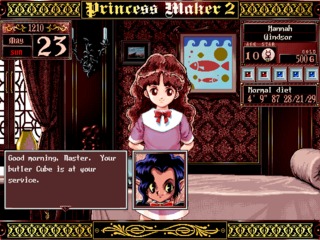Survival Kids is a survival adventure game developed by Konami and released in 1999 for Game Boy Color. This unique entry in Konami's catalog stands out as one of the most innovative and challenging portable games of its era, combining elements of survival simulation with adventure gameplay in a way that predates modern survival games by over a decade.
The game follows a young protagonist who becomes stranded on a deserted island after a shipwreck, forced to survive using only wit, resourcefulness, and whatever materials can be scavenged from the environment. Unlike traditional adventure games that focus on story progression and puzzle-solving, Survival Kids emphasizes realistic survival mechanics including hunger, thirst, fatigue, and shelter management. This approach feels remarkably ahead of its time, anticipating gameplay elements that would later become popular in titles like Don't Starve and modern survival simulators.
The core gameplay revolves around resource management and exploration, requiring players to constantly balance immediate needs against long-term survival goals. Finding fresh water, hunting for food, building shelter, and crafting tools from found materials forms the daily routine that drives the entire experience. The game's day-night cycle adds urgency to these activities, as nighttime brings different dangers and challenges that must be prepared for during daylight hours. This creates a compelling gameplay loop that feels more like a genuine survival simulation than the typical adventure game formula.
Visually, Survival Kids makes excellent use of the Game Boy Color's capabilities, presenting detailed environments that effectively convey the isolation and beauty of the tropical island setting. The sprite work is particularly impressive in depicting the various flora and fauna that populate the island, each serving potential purposes in the survival ecosystem. Weather effects and environmental changes help create atmosphere and present new challenges, while the character animations effectively communicate the protagonist's physical and emotional state throughout the ordeal.
The crafting system represents one of the game's most sophisticated elements, allowing players to combine found materials in logical ways to create tools, weapons, and shelter improvements. This system rewards experimentation and observation, encouraging players to think creatively about how everyday objects might be repurposed for survival. The learning curve can be steep, as the game provides minimal hand-holding and expects players to discover survival techniques through trial and error, much like real survival situations.
What sets Survival Kids apart from contemporaries like Pokemon Red/Blue or other portable adventures is its commitment to realism within the survival scenario. Actions have consequences, resources are genuinely limited, and poor planning can lead to failure. The game features multiple endings based on how well players manage their survival and what choices they make throughout their island experience, providing significant replay value for those willing to master its demanding systems.
The audio design effectively supports the isolated atmosphere with minimal but impactful sound effects that emphasize the natural environment. The sparse musical score enhances rather than distracts from the survival experience, with subtle tracks that underscore the loneliness and beauty of the island setting. Weather sounds, animal calls, and environmental audio create an immersive soundscape that draws players into the survival mindset.
The game's difficulty deserves special mention, as Survival Kids makes no compromises in its commitment to challenging, realistic survival mechanics. Players must genuinely learn and adapt to succeed, making each small victory feel earned and meaningful. This uncompromising approach may frustrate some players accustomed to more forgiving adventure games, but it creates an authentically tense and rewarding experience for those who embrace its systems.
Survival Kids stands as a remarkable achievement in portable gaming, offering an experience unlike anything else in the Game Boy Color library. While it shares some DNA with adventure games like Link's Awakening in its island setting and exploration elements, its focus on survival simulation creates something entirely unique. The game's influence can be seen in modern survival titles, though few have matched its perfect balance of accessibility and authenticity. For players seeking a genuinely challenging and innovative portable adventure that rewards careful thinking and resource management, Survival Kids remains an unparalleled experience that demonstrates Konami's willingness to experiment with bold new gameplay concepts.













